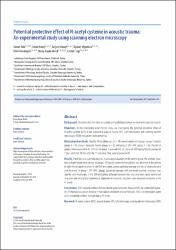| dc.contributor.author | Ada, Servet | |
| dc.contributor.author | Hanci, Deniz | |
| dc.contributor.author | Ulusoy, Seçkin | |
| dc.contributor.author | Vejselova, Djanan | |
| dc.contributor.author | Burukoğlu, Dilek | |
| dc.contributor.author | Muluk, Nuray Bayar | |
| dc.contributor.author | Cingi, Cemal | |
| dc.date.accessioned | 2019-10-20T08:00:49Z | |
| dc.date.available | 2019-10-20T08:00:49Z | |
| dc.date.issued | 2017 | |
| dc.identifier.issn | 1899-5276 | |
| dc.identifier.uri | https://dx.doi.org/10.17219/acem/64332 | |
| dc.identifier.uri | https://hdl.handle.net/11421/16185 | |
| dc.description | WOS: 000418447200001 | en_US |
| dc.description | PubMed ID: 29068588 | en_US |
| dc.description.abstract | Background. Oxidative stress has been associated with pathological processes involved in acoustic trauma. Objectives. In this prospective experimental study, we investigated the potential preventive effect of N-acetyl cysteine (NAC) in rats exposed to acoustic trauma (AT). Light microscopic and scanning electron microscopic (SEM) evaluations were performed. Material and methods. Healthy Wistar albino rats (n = 18) were divided into 3 groups: group 1 (control group, n = 6), group 2 (acoustic trauma group, n = 6), and group 3 (AT+NAC group, n = 6). The rats in group 2 were exposed to AT. The rats in group 3 received NAC at a dose of 100 mg/kg/day by gavage for 7 days, and then 10 min after the 7th-day dose, they were exposed to AT. Results. From light and scanning electron microscopy evaluations in the control group, the cochlear structure and epithelium were normal. In group 2 (AT group), extensive hair cell loss was observed in the cochlea by light microscopy evaluation. In the SEM evaluation, various epithelial damage and loss of stereocilia were also observed. In group 3 (AT+ NAC group), decreased damage with preserved cochlear structures was seen by light microscopy. In the SEM evaluation, although stereocilia loss was also seen, nearly normal cell structures and vertical and symmetrical alignment of stereocilia structures were observed compared to the AT group. Conclusions. NAC reduced cochlear damage due to acoustic trauma. Because NAC has antioxidant capacity, AT mat have caused an increase in free radicals and death of outer hair cells. NAC is an antioxidant agent and it prevented cochlear damage due to AT in rats. | en_US |
| dc.description.sponsorship | Continuous Education and Scientific Research Association | en_US |
| dc.description.sponsorship | With the exception of data collection, the preparation of this paper, including design and planning, was supported by the Continuous Education and Scientific Research Association. Only scientific support was provided; no grant or funding was received. | en_US |
| dc.language.iso | eng | en_US |
| dc.publisher | Wroclaw Medical University | en_US |
| dc.relation.isversionof | 10.17219/acem/64332 | en_US |
| dc.rights | info:eu-repo/semantics/openAccess | en_US |
| dc.subject | N-Acetyl Cysteine (Nac) | en_US |
| dc.subject | Acoustic Trauma (At) | en_US |
| dc.subject | Light Microscopy | en_US |
| dc.subject | Scanning Electron Microscopy (Sem) | en_US |
| dc.title | Potential protective effect of N-acetyl cysteine in acoustic trauma: An experimental study using scanning electron microscopy | en_US |
| dc.type | article | en_US |
| dc.relation.journal | Advances in Clinical and Experimental Medicine | en_US |
| dc.contributor.department | Anadolu Üniversitesi, Fen Fakültesi, Biyoloji Bölümü | en_US |
| dc.identifier.volume | 26 | en_US |
| dc.identifier.issue | 6 | en_US |
| dc.identifier.startpage | 893 | en_US |
| dc.identifier.endpage | 897 | en_US |
| dc.relation.publicationcategory | Makale - Uluslararası Hakemli Dergi - Kurum Öğretim Elemanı | en_US |


















